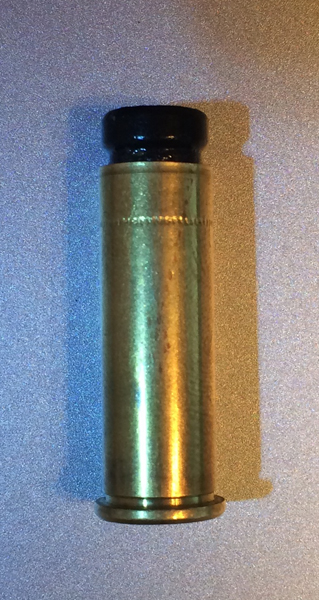Gryff
Well-known member
I have a quantity of Black Bullet 147gr. 9mm truncated cone bullets that are out of spec. They measure .358 in diameter, so they have been causing feeding/extraction issues in the 9mm semi-auto that for which they were intended.
What are the thoughts of reversing them and using them as 147gr. wadcutters for .38 Special? The intent would be to re-purpose what are currently useless bullets into .38 rounds that can be used for casual, low-power range shooting.
My current .38Spl load is 3.5gr of HP38 under 160gr. coated lead bullets (a low-recoil competition load for IDPA). When I use the setup as it stands, my press seats the reversed 147gr. bullets to a OAL of 1.156 with 0.0167" of the flat end (original base before reversing) of the bullet above the top of the case mouth (see pic). The Hodgdon's website for HP38/148gr LHBWC bullets lists an OAL of 1.16 which confuses me because I always see wadcutters loaded flush with the mouth of the case (so it should be a 1.15 OAL), but nonetheless is pretty close to the specified length.
So the question...given that I am at the low end of the Hodgdon recommended load for a 148gr. wadcutter (3.5g grains start - 4.0 grains max), is this experiment a dangerous idea for any reason?
The only issue that crosses my mind is the different shape inside the case of the reversed truncated cone bullet (instead of being a cylinder-shape like a wadcutter). But I would think that any issues would manifest more as an accuracy issue rather than an over-pressure concern.
So, looking for input from people who have played with uncommon revolver loadings.

What are the thoughts of reversing them and using them as 147gr. wadcutters for .38 Special? The intent would be to re-purpose what are currently useless bullets into .38 rounds that can be used for casual, low-power range shooting.
My current .38Spl load is 3.5gr of HP38 under 160gr. coated lead bullets (a low-recoil competition load for IDPA). When I use the setup as it stands, my press seats the reversed 147gr. bullets to a OAL of 1.156 with 0.0167" of the flat end (original base before reversing) of the bullet above the top of the case mouth (see pic). The Hodgdon's website for HP38/148gr LHBWC bullets lists an OAL of 1.16 which confuses me because I always see wadcutters loaded flush with the mouth of the case (so it should be a 1.15 OAL), but nonetheless is pretty close to the specified length.
So the question...given that I am at the low end of the Hodgdon recommended load for a 148gr. wadcutter (3.5g grains start - 4.0 grains max), is this experiment a dangerous idea for any reason?
The only issue that crosses my mind is the different shape inside the case of the reversed truncated cone bullet (instead of being a cylinder-shape like a wadcutter). But I would think that any issues would manifest more as an accuracy issue rather than an over-pressure concern.
So, looking for input from people who have played with uncommon revolver loadings.

